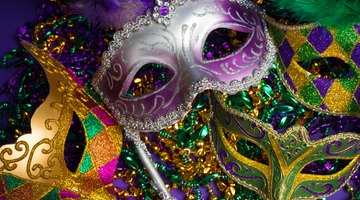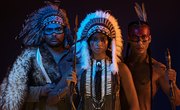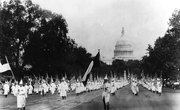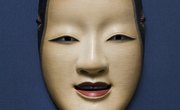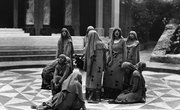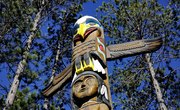The word "masquerade" has its roots in the French word "mascarade" and the Italian word "maschera," but masquerades likely originated on the West African coast. Similarities exist between the Italian Commedia dell' Arte and the Nigerian Yoruba masked comedy. Masquerade first became popular in Venice, Italy and the practice of masquerade balls quickly spread throughout Europe and England in the 18th century. During the same period, African ceremonial masquerades spread to the Caribbean and southeastern United States, where it evolved into carnivals.
West African Masquerade
According to West African custom, masquerade can refer to a performance by masked characters, the performer himself, or the character portrayed by the performer. The African style of masquerade is an outdoor event, performed by men, and sometimes limited to the attendance of men. The Ekpe masquerade has its roots in the Nigerian Cross River State and is used in ceremonies accompanied by cultural drama. The Ofirima masquerade, also originating from the Cross River State, features a lead dancer wearing a headpiece resembling a shark. The Yoruba egungun festival, a distinct form of masquerade, honors a family's ancestral spirits.
Venetian Masquerade
There is evidence that Venetians were practicing masquerade as far back as the 13th century, when documents mention masked men throwing scented eggs at ladies. Although the wearing of masks was long associated with the Venetian celebration of carnavale, 18th century artists' paintings show masquerade also was by then regularly used to conceal questionable behavior. Renderings of Venetians in gambling houses show both men and women in white, face-shaped masks known as the Bauta and women in black velvet oval masks known as the Moretta.
Masquerade in England
The masquerade balls of 18th century England were based on the Venetian carnivals and retained an atmosphere of the carnivalesque. Masquerade festivals sometimes honored a member of royalty or celebrated a special event. For all their gaiety, however, masquerades balls and festivals had strict rules. Costumes had to make the wearer unidentifiable and conversations between attendees began with set phrases such as "I know you" and "Do you know me?" Masquerade celebrations allowed participants to leave social mores and standing behind. Men dressed as women, women as men, and there was much intermingling of social classes as the lower classes often could afford tickets to the public masquerades.
Caribbean and American Carnivals
Carnival, an annual celebration in the Caribbean islands involving masquerade performance, originated on the islands of Trinidad and Tobago. It is a mixture of folklore and religion. Jankunu is a carnival-style masquerade parade that takes place in many Caribbean islands on Boxing Day, New Years Day and, in Grand Bahamas, the summer. Jankunu parades are also held in Miami and Key West, Florida, and in Knoxville, Tennesee. Mardi Gras, originally a pagan celebration of Spring, also features masquerade. The celebration was later incorporated into Christian Lenten traditions in Italy, Spain and France.
Related Articles
References
- University of Michigan: General Commonalities in The Masquerade
- Articles from the 1997 Festival of American Life Program Book: Ikeji Masquerade, Ofirima Masquerade
- University of Michigan: The World Upside Down: 18th Century Masquerades: General Commonalities in The Masquerade
- University of Michigan: The World Upside Down: 18th Century Masquerades: The Inter-mingling of The Classes at Masquerades
- History.com: Mardi Gras: Origins of Mardi Gras
Resources
Writer Bio
Laura Leddy Turner began her writing career in 1976. She has worked in the newspaper industry as an illustrator, columnist, staff writer and copy editor, including with Gannett and the Asbury Park Press. Turner holds a B.A. in literature and English from Ramapo College of New Jersey, with postgraduate coursework in business law.

